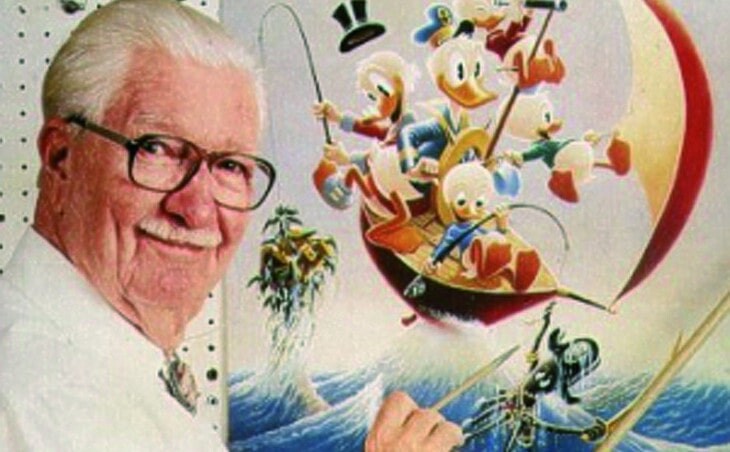Did you know that on September 18, 1987, the first episode of Duck Tales was aired ? And this year is the one hundred and twentieth birthday of the creator of Duckversum? He was also a consultant for the series about ducks, so we want to present you his profile briefly.
Duck Dad
Born in 1901 on a ranch near Merrill, Oregon, Carl Barks has spent most of his life drawing, illustrating, painting and telling stories about the ducks of the Disney world. It is true that he was not the creator of Donald Duck, because he joined Disney a year after the premiere of the cartoon Wise Hen , but ducks he loved the most. He initially worked at Walt Disney Productions as a storyboard artist and co-writer. He worked on such famous cartoons as Donald’s Nephews (1928) and Donald’s Cousin(1939). He was known under a number of pseudonyms including “The Good Duck Artist”, “The Duck Man”, “Good Artist” and “King of Comics” for his work on Donald Duck in a time before artists were recognized. For many years, Carl was an outstanding Disney comic book creator.
In the cartoons, Donald is mostly a lazy playboy who is hard to understand by his quacking. To make it suitable for a comic book, Barks made the text we see in the balloons more understandable to the potential recipient than the bizarre yet charming gibberish. In addition, Donald Duck began to show more emotion than just anger or joy. Worry, compassion, and even depression ensued. In creating Scrooge McDuck, Carl Barks did more than any other comic book writer to expand Donald Duck’s popularity by creating a universe of peculiarity within Disney animators. We got an unforgettable Duckburg with supporting characters such as Goguś, Diodak and Wolframik, Brothers Be or Young Scouts.
In both types of stories – ten-page comedies and longer adventure stories – which he created in 1942-1966, he managed to convey the intricacies and subtleties of the full range of human emotions in the form of not only Donald himself, but also his friends and enemies, while revealing the essence of exotic locations from four corners of the world (from scorching deserts and primeval forests, through wet jungles and frosty, snow-capped mountains, to the urban scenery of Duckburg). His mastery is evidenced by, inter alia, the tribute of “Newsweek” to his artistry and the conclusion of “Time” that “Scrooge and its creator Carl Barks belong to the great mainstream American folklore.”
Źródło: d23.com
Extended popularity
Of course, good work has translated into growing popularity. His many fans included George Lucas and Steven Spielberg, who were inspired by adventure comics. One South American adventure , the 1959 Pizarro Prize in particular, gave the idea for the sequences in all two of Indiana Jones’ films – The Lost Temple Traps in the opening sequence before Raiders of the Lost Ark (1981) and the ending scenes of Indiana Jones and the Last Crusade(1989). Lucas himself claimed that when he discovered McDuck’s character as a child, he liked him “so much that he immediately went out and bought all the Uncle Scrooge comics he could find in sight.” Barks stories were repeatedly duplicated in Disney comics around the world, and after his retirement in 1966 (the same year Walt Disney, born nine months after Barks died), he continued to work with Mickey Mouse. Overall, it is estimated that his works are 6,371 pages long, which translates into around 450 comics. He achieved such an impressive number thanks to his great readership, and this is also due to Disney, which is the world’s largest publisher of magazines and books for children (every year over two billion people around the world read a book or a Disney magazine).
Źródło: donaldduck.fandom.com
Some real life facts
Born on a farm in Oregon, on March 27, 1901, Carl Barks left school at the age of 15 and spent the next two decades in manual labor as a rancher, lumberjack, railroad mechanic, and printer. During the Great Depression, he became an illustrator for a humorous magazine, eventually becoming its most productive member. In 1935, he joined the Disney studio where he became a storyboardist. His health problems eventually forced Barks to leave the Burbank studio during World War II, because the dry air of the California desert was not serving him, so he switched to comics.
And this is how, after the age of 40, Carl Barks made a great step in his life. His name slowly began to enter the annals of eternal art, as he decided to create outstanding comic stories. Despite his retirement (and as his name was slowly becoming famous), “Unca Carl” continued to be active. He began to paint specially signed oil paintings of his Disney ducks; paintings that sometimes cost more than $ 100,000. Indeed, it’s easy to forget that Barks’ retirement lasted much longer than his comic book career, and that he spent many more years in front of the canvas than on the drawing board.
In fact, Barks lived to a ripe old age of almost 100. He remained lively and active until the end. His pace was so intense that during his 1994 trip to Europe (the first outside North America) to celebrate Donald’s 60th birthday, Disney’s young mentors and PR staff at Disneyland Paris had to pick up the pace to keep up with the 93-year-old. His philosophy can be summed up in the following words: “I worked hard trying to do as good as I could … I have always tried to write a story that I wouldn’t mind myself.” Carl Barks died in 2000.
Źródło: lambiek.net

